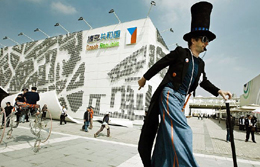
The Chinese want to buy the Czech pavilion at Expo 2010
 |
The state has allocated half a billion crowns for the Czech presence at the expo in China, reminded Czech foreign minister Jan Kohout today in Shanghai. After the exhibition, the pavilion could serve in a commercial area. It is likely that the famous golden tear, which is part of the installation for creating personal perfumes, could also be included, although in a copy. The reliefs from under the statue of John of Nepomuk, which were brought as a symbol of luck from the Charles Bridge, will definitely be returned to Prague, emphasized Stehlík.
"We must return the reliefs to Bohemia, the golden drop is on loan, but since every sculptural work can be made in six originals, I think there is room for negotiation about the golden drop," Stehlík said regarding the installation by Federico Díaz.
Two weeks after the opening of the expo "Fruits of Civilization," it was visited by half a million people. The pavilion features over twenty exhibits and an exhibition about the Chinese monkey king. Today, the Czech national day with a cultural program is being held at the expo grounds.
Stehlík said that before selling the pavilion, he must legally offer it to Czech state institutions to see if they are interested. "Only after they say they don’t want it can we negotiate about the sale," he clarified. He did not know when the government might consider the matter.
The location where the pavilion could potentially stand if the negotiations succeed is still being kept secret by Stehlík. "It is no more than 400 kilometers from Shanghai, it is a relatively large city, and yesterday we had a meeting with the mayor. We agreed to meet at their place and discuss where it could be," said the general commissioner. "I thought it was a beautiful idea, and I hope we find a way to agree," he added.
The cloak of the Czech pavilion is white and decorated with black pucks. Compared to other pavilions, it has a more modest exterior but is said to impress with its originality inside.
Among the greatest successes of Czech and Czechoslovak exhibitions was undoubtedly the Brussels pavilion from 1958. The exhibition then received the highest award - the Golden Star. The semi-circular restaurant Prague, which was part of the pavilion, is now located in Letná Gardens in Prague. The audience was also captivated by Laterna magika back then.
Already in 1937, the pavilion by architect Jaromír Krejcar was one of the highlights of the Paris expo. The glass and steel building, which was praised by the famous functionalist Le Corbusier, became one of the peaks of Czechoslovak interwar architecture.
The exhibition of reliefs from the Charles Bridge is not a completely new phenomenon either. At the Montreal Expo in 1967, similar exhibits included the Třebechovice nativity scene, the altar of Master Paul from Levoča, and paintings by Master Theodorik from Karlštejn.
After several less successful exhibitions, a replica of the Chapel of the Holy Cross from Karlštejn attracted 1.8 million visitors at the Hanover expo in 2000. The interactive Garden of Music was viewed by almost the same number of visitors in Aichi, Japan, in 2005.
The English translation is powered by AI tool. Switch to Czech to view the original text source.
0 comments
add comment












